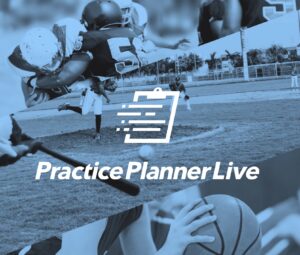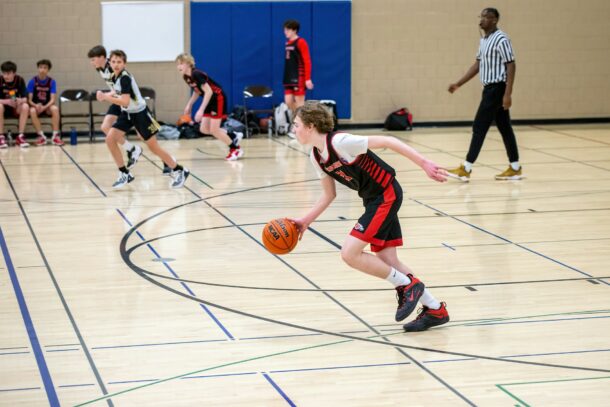Regardless of the age or gender of your athletes, or the amount of coaching experience you possess it is probably safe to assume that you have established some sort of offensive philosophy. While every coach is surely unique, all offensive philosophies can be boiled down to two distinct types; motion offense or the use of quick hitters.
There are many coaches who insist on arguing that one type is certainly better than the other, but the fact of the matter is that there are multiple ways to be successful. Instead of blindly following the crowd, my advice is to simply implement what you are most comfortable teaching!
Utilizing a motion type of offense offers several advantages.
- All five players will be involved in the offense
- There are equal scoring opportunities for all players
- Teams who are not as quite athletic but more disciplined than their opponents can thrive in this system
However, a quick hitting offense also has its advantages:
- Quicker scoring opportunities often results in more scoring opportunities
- Your best players get the most shots
- Favors an up tempo style of play
If you are a coach who has already established a quick hitting offensive philosophy or are looking into changing to this style of play, here are 6 tips for improving your quick hitters.
Tip 1: Check the Speedometer
Remember a quick hitter is intended to be carried out quickly! One of the biggest flaws that many coaches fail to notice/correct is the speed at which the play is being executed! Running the set in a speedy fashion does a couple different things;
- Puts the defense in a situation where each player has to react quickly
- If even one defender fails to react quickly or correctly your offense will surely be left with a wide open shot attempt
Tip 2: Know the Scoring Options
One of the biggest advantages of running a quick hitter is that you can dictate and control the scoring opportunities! You can easily place your top three scorers in positions where in a matter of seconds one or all of them will receive multiple looks at the basket. First of all, make sure the plays you select compliment the strengths of your top players.
Secondly, make sure your every player knows and understands the sequence of available scoring options. It’s extremely frustrating and usually counterproductive when a role player takes the first shot opportunity instead of waiting for the play to develop.
Tip 3: Maintain Great Spacing
A common objective in many quick hitters is to develop mismatches and then exploit them. However if your team does not maintain great spacing throughout the set it will make it much easier for the defense to prevent any mismatches. Great spacing also allows for other scoring opportunities outside your “big three.”
With so much focus placed on your primary scorers, the defense often will not be able to properly guard all five offensive players. With proper spacing your role players will usually find themselves in many more scoring situations than if everything is bunched up.
Tip 4: Set Good Screens
No matter which type of offense you run, whether it is motion or quick hitters, you will need to establish good screening actions. By setting good screens you can free up shooters for open shots, make it easier to reverse the ball, put defensive players in situations where they have to make instant decisions, and create mismatches for your best scorers.
Although some coaches may think of the ability to set good screens as a minor issue, I promise you it makes the world of difference when done properly and consistently.
Tip 5: Stress Execution
When utilizing a quick hitting system it can occasionally be very easy for players to get caught up in playing and completely abandon the play. While this may be acceptable in certain situations, it may be very detrimental in others.
Hold your players accountable and stress perfect execution. The players must have trust in you as their coach and allow the play to unfold before improvising or going to “Plan B.”.
Tip 6: Quick Hitter into Motion
This tip is a little more advanced than the others but can pay huge dividends! As mentioned before, many quick hitters are designed to establish mismatches and then to exploit them. If you can coach your team to transition your quick hitters smoothly into a motion type offense, the defense will have no time to adjust between the two different philosophies in order to counteract the mismatch.
Using this strategy forces opponents to not only defend the initial quick hitter but also the disciplined movement of your motion. For younger teams this is nearly impossible!
Bonus Tip: If you are coaching older players, try running a motion type offense that leads into a quick hitter. If you play with a shot clock, run motion for 1-20 seconds. Then get right into a predetermined quick hitter. (If you don’t play with a shot clock try using a set number of passes as a guideline.) This strategy will give you the best of both offensive worlds. It will keep the defense constantly off balance, and is extremely difficult to scout.
Related: Motion Offense Pros and Cons for Coaches
Resources:
 Practice Planner Live
Practice Planner Live
Failing to prepare is preparing to fail! Quickly create, organize, & manage your practice plans all in one place to help win games.
Create detailed practice plans! Add drills, notes, diagrams, videos, & groups with an easy-to-use interface to create a detailed practice plan in no time!
Take a risk free,14-day trial at PracticePlannerLive.com today! No credit card required!
If you found this useful, don’t forget to check out additional blog posts at TeachHoops.com. Also, check out TeachHoops on Facebook, Twitter, Instagram and YouTube.







